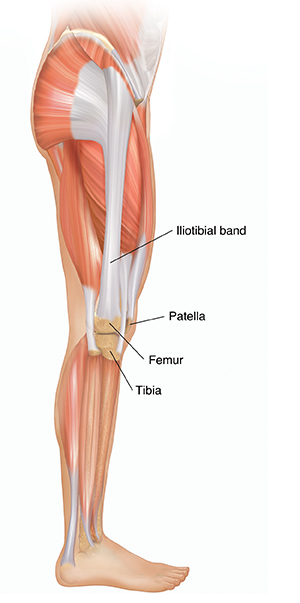Understanding Iliotibial Band Syndrome
Iliotibial (IT) band syndrome is a condition that causes pain on the outside of the knee. It most often occurs in athletes, especially long-distance runners. It can also happen if you cycle, ski, row, or play soccer. It can also occur in people who are just starting to exercise.
What is the IT band?
The iliotibial (IT) band is a strong, thick band of tissue that runs down the outside of your thigh. It goes all the way from your hipbones to the top of your shinbone (tibia), just below your knee joint. The bones of your knee joint include your tibia, your thighbone (femur), and your kneecap (patella).
When you bend and straighten your leg, the IT band moves over the outer lower edge of your femur. Over time, bending and straightening your leg can cause the IT band to irritate nearby tissues and cause pain.

What causes IT band syndrome?
Researchers are still learning the exact cause of IT band syndrome. The pain may be caused by the IT band rubbing over the lower outer edge of the femur. This may cause inflammation in the bone, tendons, and small fluid-filled sacs (bursa) in the area. The IT band may also squeeze (compress) the tissue under it and cause pain.
If you are a runner, you might be more likely to develop IT band syndrome if:
-
You run on uneven ground or down hills
-
You run in worn-out shoes
-
You run many miles per day
-
Your legs bend in a little from your knee to your ankle (bowlegs)
What are the symptoms?
IT band syndrome causes pain on the outside of the knee or side of the thigh. It might affect one or both of your knees. The pain is an aching, burning feeling that can spread up the thigh to the hip. You may feel this pain only when you exercise, such as while running. The pain may be worst right after you step on your foot. It may only happen near the end of your exercise. As the condition gets worse, pain may start earlier. It may continue after you stop exercising. Going up and down stairs may make the pain worse.
How is IT band syndrome diagnosed?
Your healthcare provider will ask about your health history and your symptoms. They will give you a physical exam. This will include an exam of your knee. The range of motion and strength of your knee will be tested. The provider will look for areas of pain around your knee, thigh, and hip. The symptoms of IT band syndrome can be like those of osteoarthritis or a meniscal tear. Your provider will make sure IT band syndrome is the cause of your symptoms. If the diagnosis is not clear, you may need imaging tests. These can include an X-ray or MRI scan.